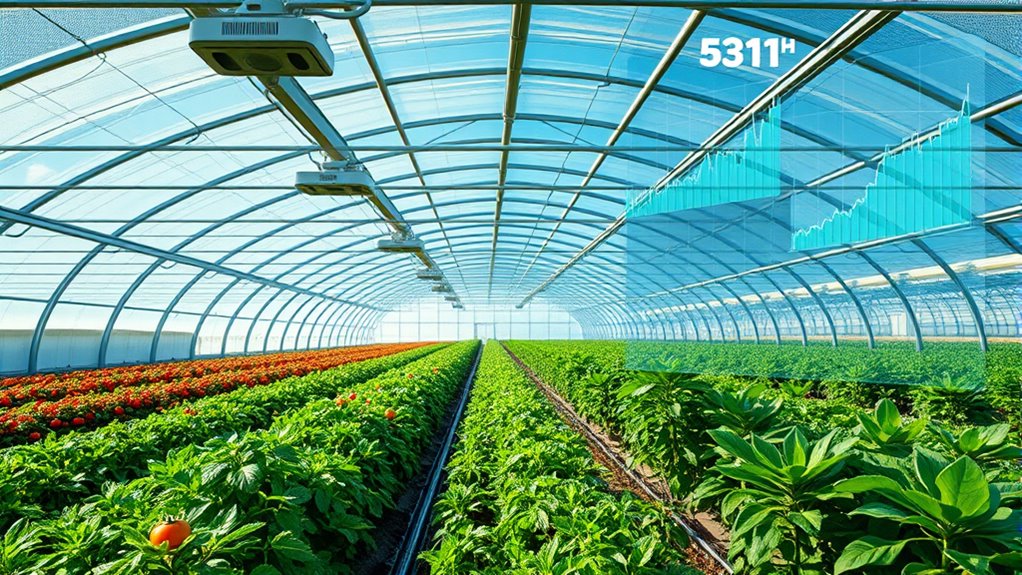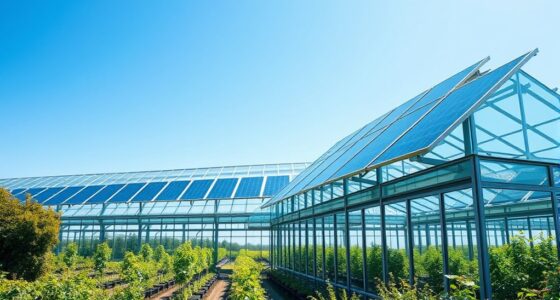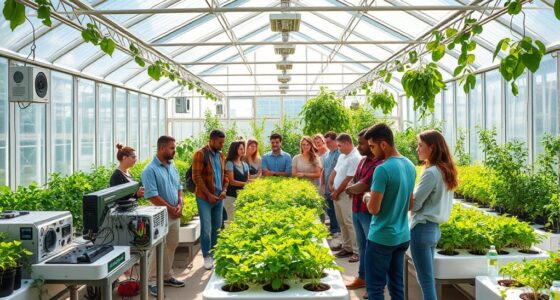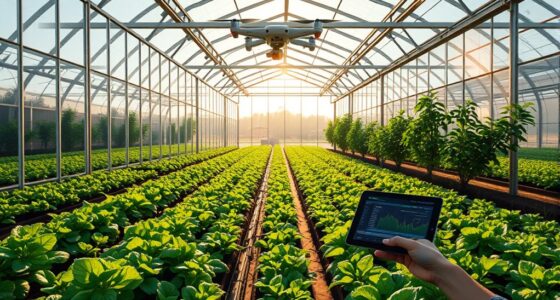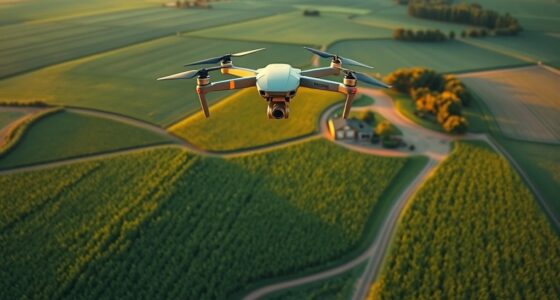Predictive analytics in greenhouses uses sensor data, weather forecasts, and crop information to optimize growing conditions and boost yields. By analyzing this data, you can make proactive adjustments to climate controls, water, and nutrients, reducing waste and improving efficiency. This approach helps prevent issues like disease and stress early on, leading to healthier crops. Continue exploring how leveraging data can transform your greenhouse management and maximize productivity.
Key Takeaways
- Predictive analytics enables proactive climate and environmental adjustments, optimizing crop growth and yield outcomes.
- It helps precisely allocate resources like water and nutrients, reducing waste and enhancing efficiency.
- Data-driven models forecast disease, pest risks, and weather impacts, allowing timely interventions.
- Integration of monitoring systems with predictive algorithms improves environmental control accuracy.
- Overall, it increases crop quality, consistency, and profitability by supporting informed decision-making.
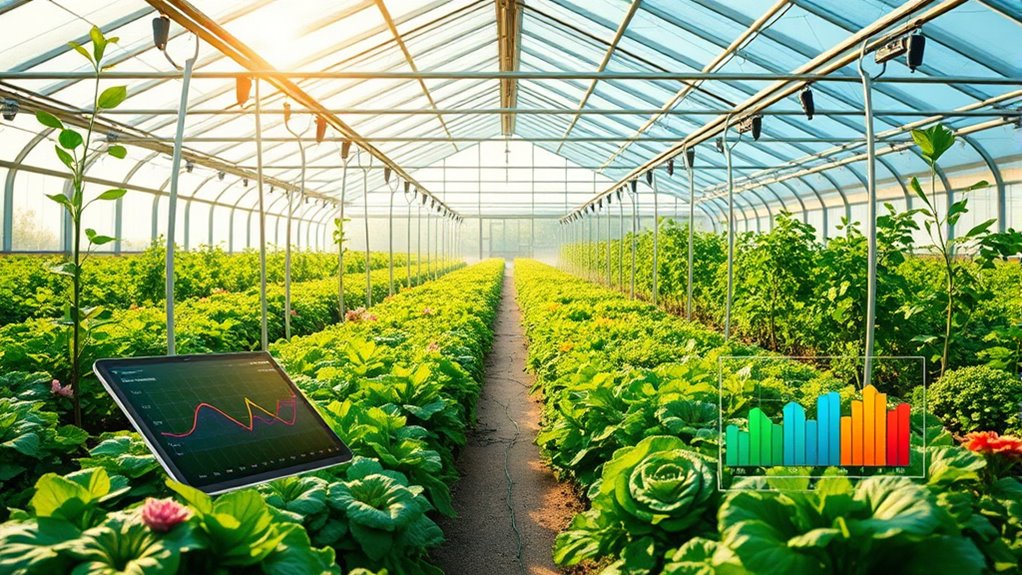
Predictive analytics is transforming how greenhouses operate by enabling growers to anticipate and respond to environmental and crop conditions more effectively. By analyzing vast amounts of data from sensors, weather forecasts, and historical trends, you can make informed decisions that improve crop yields and reduce waste. One of the most significant advantages of this technology is its ability to support climate adaptation. Greenhouse environments are sensitive to fluctuations in temperature, humidity, and light, all of which influence plant health. With predictive analytics, you can identify patterns indicating potential stress or disease before they become visible, allowing you to adjust climate controls proactively. This continuous monitoring helps create a stable environment tailored to each crop’s specific needs, even as external conditions change unpredictably.
Predictive analytics helps greenhouses adapt to environmental changes by identifying stress and disease patterns early for proactive climate control.
Resource utilization is another critical benefit that comes from leveraging predictive analytics in your greenhouse. Instead of relying on fixed schedules or reactive measures, you can fine-tune resource use such as water, nutrients, and energy based on real-time data. For example, sensor data can reveal when plants actually need watering, preventing over-irrigation that wastes water and risks root rot. Similarly, nutrient delivery can be adjusted precisely to match plant growth stages, reducing fertilizer runoff and lowering costs. Energy consumption, often a significant expense in greenhouse operations, can be minimized by predicting ideal heating, cooling, and lighting periods, ensuring you’re not wasting resources during unnecessary times. Additionally, understanding regional divorce statistics can help you consider external factors that influence market demand and operational planning. Incorporating data-driven decision making further enhances your ability to optimize processes and improve overall productivity. Utilizing environmental monitoring systems allows for even more precise adjustments, ensuring optimal growing conditions at all times. In addition, integrating predictive algorithms with existing systems can significantly enhance accuracy and operational efficiency.
Implementing predictive analytics also helps you streamline your overall management practices. By integrating data from various sources—climate sensors, crop health images, and market trends—you gain a thorough view of your operation. This holistic perspective allows you to make more strategic decisions, such as adjusting planting schedules or selecting resilient crop varieties better suited for upcoming climate conditions. The ability to forecast crop performance and environmental responses enables you to plan more accurately, reducing risks associated with unpredictable weather or pest outbreaks. Moreover, incorporating data analytics into daily operations can significantly improve your resource efficiency and crop outcomes.
Ultimately, harnessing predictive analytics empowers you to operate a more efficient, sustainable, and resilient greenhouse. It shifts your approach from reactive to proactive, enabling you to prepare for environmental challenges rather than just respond to them. As a result, you’ll see improvements in crop quality, yield consistency, and resource use efficiency, all of which contribute to a more profitable and environmentally responsible greenhouse operation.
Frequently Asked Questions
How Accurate Are Predictive Models in Diverse Greenhouse Environments?
You might wonder how accurate predictive models are across diverse greenhouse environments. Their accuracy depends on model adaptability and data reliability. If models are designed to adjust to varying conditions and your data is consistent and high-quality, predictions become more reliable. However, environmental differences can challenge model accuracy, so regular updates and robust data collection are essential. This way, you can optimize yields regardless of greenhouse variability.
What Are the Initial Costs for Implementing Predictive Analytics Systems?
About $10,000 to $50,000 is a typical initial investment for implementing predictive analytics systems in your greenhouse. This covers cost considerations like hardware, software, and training. You should also factor in technology investments that can boost efficiency and yields. While the upfront costs seem high, the long-term benefits often outweigh the initial expenses, making it a smart move for sustainable growth.
How Do Weather Variations Impact Data Accuracy and Predictions?
Weather unpredictability can challenge your data accuracy and predictions because sudden changes may not be captured promptly. You need to regularly calibrate your sensors to guarantee reliable data collection. Fluctuating weather conditions can lead to discrepancies if your system isn’t adaptive. By improving sensor calibration and accounting for weather variability, you enhance your predictive model’s precision, helping you make better decisions and optimize greenhouse conditions despite unpredictable weather patterns.
Can Predictive Analytics Adapt to Changing Crop Varieties?
Your predictive analytics can adapt to changing crop varieties more easily than you’d imagine. With crop genetic adaptation and data model flexibility, you can stay ahead of the curve, even as new varieties emerge overnight. These advanced systems learn and evolve, ensuring your predictions remain accurate regardless of crop changes. Think of it as your data’s superpower — transforming your greenhouse into a future-proof, yield-boosting powerhouse!
What Training Is Required for Greenhouse Staff to Use These Tools Effectively?
You need to focus on staff training that emphasizes technology integration to use predictive analytics tools effectively. Start with hands-on workshops to familiarize your team with new software and data interpretation. Guarantee ongoing education to keep up with evolving technology. By investing in thorough training, you’ll empower your staff to make data-driven decisions confidently, improving greenhouse management and crop yields through smarter, more efficient use of predictive analytics tools.
Conclusion
As you harness the power of predictive analytics in your greenhouse, you’re on the brink of revealing unprecedented yields. The data points are there, waiting to reveal secrets that could transform your growing strategies. But the real breakthrough lies just beyond the horizon—what will you discover when you truly start listening to your data? The future of your greenhouse success depends on it. Are you ready to take that next leap?
